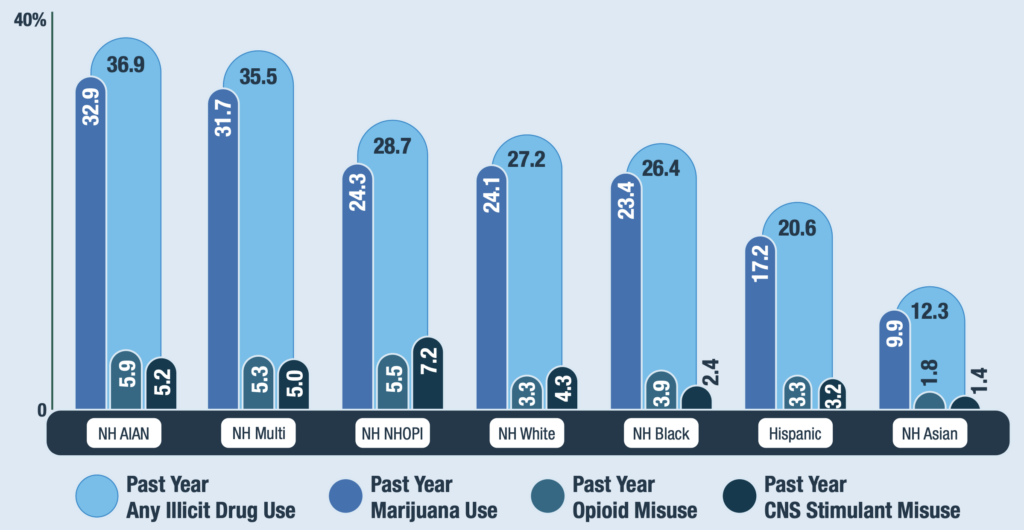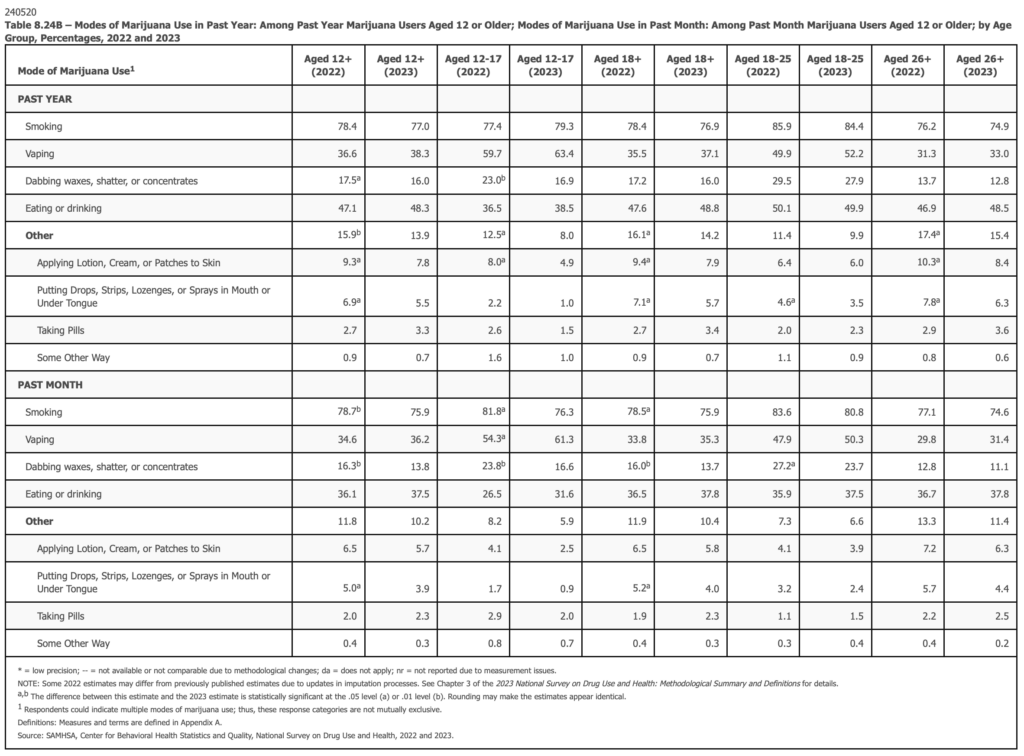Teen Marijuana Use Is Lower Now Than Before States Started Legalizing It For Adults, Federal Report Shows
FeaturedMarijuana IndustryMarijuana Industry News August 5, 2024 MJ Shareholders 0
Past-year marijuana use held roughly steady nationally between 2022 and 2023, according to a new federal report published by the Substance Abuse and Mental Health Services Administration (SAMHSA). Cannabis consumption among minors, meanwhile—defined as people 12 to 20 years of age—has fallen slightly, according to the new data.
And despite methodological changes in recent years that make comparisons difficult over time, youth use appears to have fallen significantly in the past decade, as dozens of states have legalized marijuana for adult or medical use. Notably, the percentage of young people aged 12 to 17 who’ve ever tried marijuana dropped 18 percent from 2014, when the first legal recreational cannabis sales in the U.S. launched, to 2023. Past-year and past-month rates among young people also declined during that time period.
Among adults of all ages, marijuana remains “the most commonly used illicit drug,” says the 2023 National Survey on Drug Use and Health (NSDUH), which the government published on Tuesday. More than 1 in 5 Americans (21.8 percent) reported having used cannabis within the past 12 months. That’s compared to 22.0 percent in 2022.
The rate is roughly the same as for Americans reporting binge drinking within the past month (21.7 percent).
Among underage respondents—those aged 12 to 20—18.4 percent reported using marijuana at least once within the past year in 2023, down from 19.2 percent the year before. As for monthly use, 11.3 percent of minors surveyed said they consumed marijuana within the past month. By comparison, 14.6 percent of underage respondents said they used alcohol within the past month.
Across all respondents, the use rate of any illicit drug—which includes “marijuana, cocaine, heroin, hallucinogens, inhalants, and methamphetamine, as well as the misuse of prescription drugs,” according to the report—was 24.9 percent, or about 1 in 4 Americans. That’s the same proportion as in 2022. The percent of people who said they used an illicit drug other than marijuana in the past 12 months also held steady from 2022 through 2023, at 8.8 percent.
Regarding alcohol, nearly half (47.5 percent) of all respondents said they drank within the past month, compared to 48.7 percent in 2022 and 47.4 percent in 2021. Binge drinking, defined as having several drinks in one day, stayed flat at 21.7 percent—the same as in 2022 and 2021—as did heavy alcohol use, defined as binge drinking on at least five days within the past month.
In 2023, 5.8 percent of Americans said they were heavy drinkers, compared to 5.7 percent in 2022 and 2021. Among minors, 1.7 percent reported heavy drinking.

2023 NSDUH / SAMHSA
The annual survey, SAMHSA said, “provides nationally representative data on the use of tobacco, alcohol, and drugs; substance use disorders; mental health issues; and receipt of substance use and mental health treatment among the civilian, noninstitutionalized population aged 12 or older in the United States.”
While the NSDUH survey has been conducted for decades, its methodology has changed over the years, making some historical comparisons difficult or impossible. Data from recent years, including 2023, 2022 and 2021 “should not be combined with data from 2020 or prior years for a variety of methodological reasons,” a SAMHSA spokesperson said in an email.
Nevertheless, the advocacy group NORML made the following comparisons from the available data:
“NSDUH data reports that the percentage of those ages 12 to 17 who reported having ever tried marijuana fell 18 percent from 2014 to 2023. Those reporting having consumed cannabis during the past year fell 15 percent. The percentage of teens reporting current marijuana use fell 19 percent.”
“Sensational claims that adult-use legalization laws are linked with greater marijuana use by teens are simply not backed by reliable data,” said NORML’s deputy director, Paul Armentano. “These government findings ought to reassure lawmakers that cannabis access can be legally regulated in a manner that is safe, effective, and that does not inadvertently impact young people’s habits.”
On the other side of the issue, Kevin Sabet, the president of the anti-marijuana advocacy group Smart Approaches to Marijuana, used the release of the report to reiterate his opposition to federal rescheduling of marijuana.
“These drugs aren’t safe and they aren’t medicine,” he said. “This latest round of data should make it even more apparent that marijuana doesn’t meet the criteria to be rescheduled by the federal government.”
While Sabet and SAM noted that marijuana use among all respondents has gone up in recent decades, the group’s social media thread was silent on the steady or falling youth use rates evident in the latest NSDUH report. The group warned instead that “twenty years of deliberate deceit coupled with new products engineered for addiction have built an industry that will likely soon overtake Big Tobacco as America’s vice of choice.”
By race, the survey found that self-reported past-year cannabis use was highest among American Indian or Alaska Native (AIAN) respondents, followed by Multiracial (Multi), then Native Hawaiian or Other Pacific Islander (NHOPI), White, Black, Hispanic and then Asian respondents. That’s despite most states enforcing marijuana laws disproportionately against Black and brown people.

2023 USDUH / SAMHSA
In its prior 2022 report, NSDUH for the first time asked respondents about their methods of marijuana consumption—including “smoking; vaping; dabbing waxes, shatter, or concentrates; eating or drinking; putting drops, strips, lozenges, or sprays in their mouth or under their tongue; applying lotion, cream, or patches to their skin; taking pills; or some other way.”
The survey found that smoking was by far the most popular form of consumption among all respondents, with more than three quarters of past-month or past-year cannabis users reporting smoking marijuana. After that came infused edibles and beverages, then vaping, then dabbing. Less common form factors, including tinctures, topicals, capsules and others, were far less popular, the survey found.
As for CBD products, about 9.8 percent of Americans 12 and older said they consumed CBD within the past month, and 18.2 percent said they used the cannabinoid within the past year. That’s down slightly from 2022 data, which found 19.8 percent past-year use and 10.5 percent use within the past month.

2023 NSDUH / SAMHSA
NSDUH reports released last year and the year before were published later in the year, in autumn. The SAMHSA spokesperson said that the “previous two years were delayed due to the work required behind the scenes to respond to methodological changes in the survey because of the COVID-19 pandemic.”
A separate poll published recently found that that more Americans smoke marijuana on a daily basis than drink alcohol every day—and that alcohol drinkers are more likely to say they would benefit from limiting their use than cannabis consumers are.
U.S. adults who drink alcohol are nearly three times as likely to say they’d be better off reducing their intake of the drug compared to marijuana consumers who said they’d benefit from using their preferred substance less often, the survey found. Further, it found that while lifetime and monthly alcohol drinking among adults was far more common than cannabis use, daily marijuana consumption was slightly more popular than daily drinking.
An earlier report published in the Journal of Studies on Alcohol and Drugs that found that secondhand harm caused by marijuana use is far less prevalent than that of alcohol, with respondents reporting secondhand harm from drinking at nearly six times the rate they did for cannabis.
Data from a Gallup survey published last August also found that Americans consider marijuana to be less harmful than alcohol, cigarettes, vapes and other tobacco products.
Another study out of Canada, where marijuana is federally legal, found that legalization was “associated with a decline in beer sales,” suggesting a substitution effect.
Separate research published earlier this year found that the use of marijuana alone was not associated with higher risk of a car crash, while alcohol—whether used by itself or combined with marijuana—showed a clear correlation with increased odds of a collision.
As for legalization’s impact on youth use of marijuana, multiple studies have debunked the idea that the reform broadly increases youth use, with most finding that consumption trends are either stable or decrease after the reform is implemented. Use by heavy users may increase, however.
For example, a research letter published by the Journal of the American Medical Association (JAMA) in April said there’s no evidence that states’ adoption of laws to legalize and regulate marijuana for adults have led to an increase in youth use of cannabis.
Another JAMA-published study earlier that month that similarly found that neither legalization nor the opening of retail stores led to increases in youth cannabis use.
Data from a recent Washington State survey of adolescent and teenage students found overall declines in both lifetime and past-30-day marijuana use since legalizations, with striking drops in recent years that held steady through 2023. The results also indicate that perceived ease of access to cannabis among underage students has generally fallen since the state enacted legalization for adults in 2012.
Rates of youth marijuana use in Colorado, meanwhile, declined slightly in 2023—remaining significantly lower than before legalization. That’s according to results of the biannual Healthy Kids Colorado Survey released this month that found that past-30-day use of cannabis among high schoolers was at 12.8 percent in 2023, a dip from the 13.3 percent reported in 2021.
A separate study late last year also found that Canadian high-school students reported it was more difficult to access marijuana since the government legalized the drug nationwide in 2019. The prevalence of current cannabis use also fell during the study period, from 12.7 percent in 2018–19 to 7.5 percent in 2020–21, even as retail sales of marijuana expanded across the country.
In December, meanwhile, a U.S. health official said that teen marijuana use has not increased “even as state legalization has proliferated across the country.”
“There have been no substantial increases at all,” said Marsha Lopez, chief of the National Institute on Drug Abuse’s (NIDA) epidemiological research branch. “In fact, they have not reported an increase in perceived availability either, which is kind of interesting.”
Another earlier analysis from CDC found that rates of current and lifetime cannabis use among high school students have continued to drop amid the legalization movement.
A study of high school students in Massachusetts that was published last November found that youth in that state were no more likely to use marijuana after legalization, though more students perceived their parents as cannabis consumers after the policy change.
A separate NIDA-funded study published in the American Journal of Preventive Medicine in 2022 also found that state-level cannabis legalization was not associated with increased youth use. The study demonstrated that “youth who spent more of their adolescence under legalization were no more or less likely to have used cannabis at age 15 years than adolescents who spent little or no time under legalization.”
Yet another 2022 study from Michigan State University researchers, published in the journal PLOS One, found that “cannabis retail sales might be followed by the increased occurrence of cannabis onsets for older adults” in legal states, “but not for underage persons who cannot buy cannabis products in a retail outlet.”
The trends were observed despite adult use of marijuana and certain psychedelics reaching “historic highs” in 2022, according to separate data released last year.
Legalizing Marijuana Leads To ‘Substantial Decrease’ In Intimate Partner Violence, Study Shows
Photo courtesy of Mike Latimer.
MJ Shareholders
MJShareholders.com is the largest dedicated financial network and leading corporate communications firm serving the legal cannabis industry. Our network aims to connect public marijuana companies with these focused cannabis audiences across the US and Canada that are critical for growth: Short and long term cannabis investors Active funding sources Mainstream media Business leaders Cannabis consumers











No comments so far.
Be first to leave comment below.